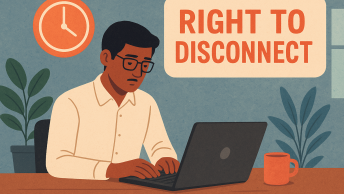In this piece, the author argues that the deceased deserve a right to dignity and cautions against the dangers of AI-driven digital resurrections, which could reduce the dead to mere commodities. To illustrate this point, the author creates a digital persona using publicly available data, demonstrating that these digital resurrections result in pseudo-personalities that violate the deceased’s dignity
Introducing Digital Resurrection
In 2022, Marvel Studios signed a contract to use Stan Lee’s (one of Marvel Comic’s most influential writers) likeness in their movies for 20 years. With the advent of artificial intelligence (“AI”), the studios can utilise his personal data to resurrect a digital clone of him. This allows generating any scene featuring Stan Lee by simply providing a prompt. Since Stan Lee created a trust (Stan Lee Universe) before his death and gave all his rights to this entity, the contract signed between the two juristic entities was legally valid. However, that is not the case with every individual.
With the advent of thanabots (bots trained on the data of the dead) like Eternime and You, Only Virtual (“YOV”), connecting with those who have passed away has become a reality. These platforms require users to upload the personal data of their deceased loved ones, including messages, emails, audio recordings, photos, and videos. Based on this data, the AI resurrects the deceased digitally. This digital clone allows users to maintain a lasting emotional connection with their loved ones, even after they have passed away. Unlike Stan Lee, however, people rarely create such trusts which transfer their personal rights. Thus, there remain concerns about their personal data being used without their consent.
This paper argues that digital resurrection of the dead should not be allowed without prior consent. It is a violation of their dignity and should not be allowed solely on the wishes of the living. To that end, it first establishes a right to dignity for the dead. Second, it demonstrates how digital resurrection violates this right. This section illustrates the technical limitations of thanabots, presenting a comparative analysis of digital resurrections. It argues that these limitations fundamentally alter the social identity of the deceased.
The Dead’s Right to Dignity as a Human Right
Although it can be challenging to establish a legal definition, ‘dignity’ signifies the inherent value and respect that every individual deserves simply by virtue of being human. This is echoed in the Charter of Fundamental Rights of the European Union, particularly in Article 3, which states that the right to respect includes the protection of an individual’s mental integrity. For the dead, it is the right to be treated with respect and integrity, preserving their social identity, and safeguarding against actions that reduce them to mere objects for the living’s utility.
It is also important to note the difference between dignity as a ‘principle’ and dignity as a ‘right of the dead.’ The former is the core principle for the establishment of human rights. It emphasises the inherent worth and respect that every individual deserves by virtue of being human. However, as a legal right, dignity applies differently to the living and the dead. While the living assert dignity through autonomy, the dead rely on State protection (as demonstrated below). This paper limits the dead’s right to dignity as a right to integrity and respect.
This right to dignity is supported by the German philosopher Immanuel Kant, who argued that human beings should never be treated merely as a means to an end but always as ends in themselves. He emphasised that individuals possess autonomy and cannot be controlled by the will of others. While Kant never extended this argument to dead people, this article argues for such an extension.
In the context of deepfakes, Ruiter extends Kant’s argument by using identity. She asserts that deepfakes not only violate individual autonomy but also alter one’s sense of self, thereby infringing upon personal identity. Given that our personal data can remain on the internet for years, this social identity endures even after a person has died. Consequently, it can continue to violate that identity. Going forward, this part will demonstrate how the sense of self is violated for the dead.
The Law on Human Remains
The call for ethics in handling human remains started in 1989 when the Vermillion Accord on Human Remains (“Vermillion Accord”) was adopted. It provided six general principles for the appropriate display of human remains in museums, emphasising respect for the dead and honouring their wishes. This framework was further developed with the adoption of Resolution 2005/26 by the UNCHR and the Tamaki Makaurau Accord in 2006. As a result of these initiatives, various countries have enacted statutes requiring the respectful treatment of human remains. In the Indian context, the Transplantation of Human Organs and Tissues Act, 1994 (“THOTA”) was enacted to prohibit the commercial sale of human organs, as it was deemed unethical.
It has been argued previously that since the dead cannot have any interests in the living world, there is no harm in disregarding them. However, this does not give freedom to represent their remains in any manner that the living please. A person’s identity holds moral significance, and altering it raises ethical concerns. Tarlow addresses this issue in the context of naming human remains, suggesting that assigning a different identity to remains, one that may or may not be accepted by the deceased if they were alive, is inherently disrespectful. Consequently, it is irrelevant whether harm is caused to the dead or not.
The Law on Crimes Against the Dead
Another area where respecting the dead has been accepted as a common practice is criminalising violence against them. Various countries consider crimes against the dead as an immoral act, detrimental to the dignity of the dead. The question of whether the law imposes a duty on the state to seek justice for the deceased, since the dead cannot assert rights in the living world, or whether this obligation arises from the rights of the living, who are affected by witnessing such a crime or by the violation of the dignity of the deceased’s relatives, varies by country.
In India, offences against the dead are addressed under the Indian Penal Code (now the Bharatiya Nyaya Sanhita, 2023). For instance, Section 301 criminalises trespassing on burial sites and offering indignity to a human corpse, while Section 315 penalises the misappropriation of a deceased person’s property. Section 351 includes threats to a deceased person’s reputation under criminal intimidation, and Section 356 recognises defamation of the dead if it harms their reputation and causes distress to their family. While the law acknowledges the violation of the dignity of the dead, it primarily bases these violations on the impact they have on the living. Additionally, most of the provisions prohibit crimes only against the dead body and not the identity of the dead (except defamation).
One might argue that since digital resurrection will likely be conducted by the relatives of the deceased, it does not harm any living interests. Thus, even if it is perceived as a violation of the dignity of the dead, they cannot claim harm. This is resolved in the next part. It argues that since the dignity of the dead is recognised as part of Article 21 of the Constitution of India, 1950, it is the state’s responsibility to prevent such forms of resurrection.
A Claim under Article 21 of the Constitution
While none of the fundamental rights explicitly recognises the deceased’s right to dignity, the Indian judiciary has repeatedly affirmed this principle. In the case of Parmanand Katara, Advocate v Union of India, the Supreme Court held that Article 21 is not limited to the living and also applies to the dead. This has been reiterated by both the Madras HC and the Allahabad HC. The Allahabad HC has specifically stated that the term ‘person’ in Article 21 includes deceased individuals.
However, these rulings primarily focus on respecting the deceased’s body, particularly their burial and cremation rights. The courts have explicitly confined the right to dignity for the deceased to their dead body. Even the NHRC’s advisory on the right to dignity for the dead limits the scope of Article 21 to the deceased’s body. It does not extend to the social identity of the deceased, which persists beyond an individual’s death (as demonstrated below).
One might argue that the advisory also extends privacy rights to the deceased as part of the seven general principles aimed at upholding their dignity. However, in defining this responsibility, it restricts it solely to media agents, including social media, and confines the right only to the deceased’s body (prohibiting the display of explicit photos or videos of their dead bodies). Regarding social identity, the advisory only addresses privacy in the context of derogatory remarks. It does not consider cases where no remark is made, as would be the case with digital resurrection.
In the digital age, merely respecting the deceased’s body is insufficient. There are various other ways in which the dead can be disrespected without harming their body. A mere resurrection, as will be demonstrated, violates the dignity of the deceased. Using Ruiter’s reasoning, it is argued that this right should be expanded to encompass the social identity of the deceased. In the context of deepfakes, she argues that manipulating a person’s image or voice without consent violates their autonomy and distorts their sense of self. Applying this to digital resurrection, the creation of AI-generated personas of the deceased fundamentally alters their social identity, reconstructing them in ways they never consented to.
Even current world examples suggest extending the dead’s right to dignity to their personality. Social media platforms often memorialise a deceased’s account and typically do not disclose login information (even to their heirs), giving the deceased a sense of autonomy. While these platforms allow the heirs to decide the fate of the account (deleting data or otherwise), platforms refrain from transferring this data to anyone, thus respecting the deceased’s personality rights.
Additionally, courts have time and again reiterated that it is the State’s duty to protect Article 21, ensuring that the right to dignity is upheld not just for the living but also for the deceased. This is particularly important in the present case, where the dead are said to not have any interests in the living world. Unlike the living, who can contest violations of their dignity through legal means, the dead rely entirely on the proactive role of the State to protect their posthumous rights. If the right to dignity was solely contingent on active interest or the ability to claim harm, it would imply that individuals lose their fundamental rights upon death. This idea contradicts established judicial precedents that recognise the dignity of the dead as an extension of human rights. Thus, the absence of direct living-world interests does not diminish the need for protection; rather, it reinforces the State’s obligation to act as the sole guardian of posthumous dignity. In this context, digital resurrection, when conducted without consent, represents a clear breach of this duty, necessitating State intervention.
The next part demonstrates how digital resurrection violates the dead’s right to dignity.
The author is a law student at the National Law School of India Unviersity, Bangalore.
Ed. Note: This piece was edited by Hamza Khan and posted by Abhishek Sanjay from the Student Editorial Board.






